

| Change Text Size | ||
 |
 |
| |||||
On this page:
Coloboma comes from a Greek word which means "curtailed". It is used to describe conditions where normal tissue in or around the eye is missing from birth.
To understand coloboma, it is useful to be familiar with the normal structure and appearance of the eye, and the terms related to the different parts of the eye.

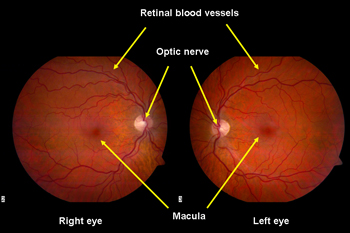
Normal fundus
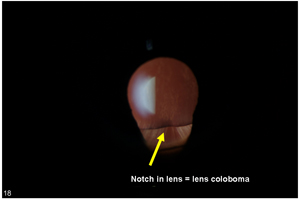
Lens Coloboma
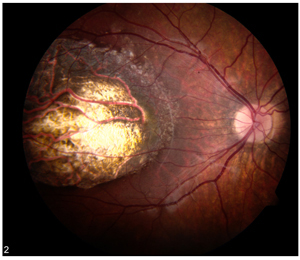
Macular Coloboma
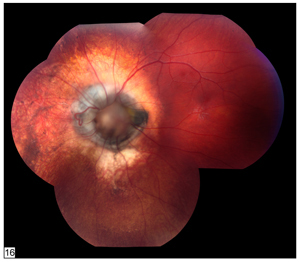
Optic Nerve Coloboma
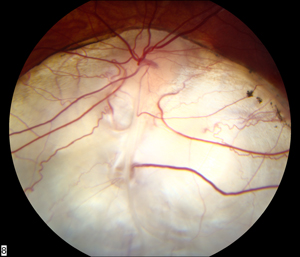
Uveal Coloboma
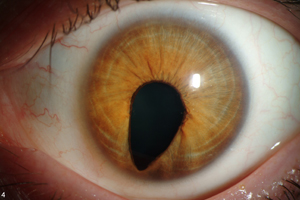
Uveal coloboma affecting the iris
There are different kinds of coloboma, depending on which part of the eye is missing. Coloboma can affect the:
In eyelid coloboma a piece of either the upper or lower eyelid is absent. Eyelid coloboma may be part of a genetic syndrome, or happen as a result of a disruption of eyelid development in a baby. A syndrome is a specific grouping of birth defects or symptoms present in one person. (www.genome.gov/glossary.cfm?key=syndrome)
In this type of coloboma, a piece of the lens is absent. The lens, which helps focus light on the retina, will typically appear with a notch.
This happens when the center of the retina, called the macula, does not develop normally. The macula is responsible for daylight, fine and color vision. Macular coloboma may be caused when normal eye development is interrupted or following an inflammation of the retina during development of the baby.
Optic nerve coloboma refers to one of two distinct things:
This coloboma can present as an iris coloboma (the iris is the colored part of the eye), with the traditional "keyhole" or "cat-eye" appearance to the iris, and/or as a chorio-retinal coloboma where the retina in the lower inside corner of the eye is missing.
To understand how uveal coloboma happens, we first have to understand how the eye forms in the developing baby. The eyes start as stalks coming out of the brain. The tip of each stalk will become the eye itself, while the rest of the stalk will become the optic nerve linking the eye to the brain. There is a seam at the bottom of each stalk, where blood vessels originally run. This seam is known as the optic fissure, or the choroidal fissure, or the embryonic fissure. Starting at the fifth week of gestation (pregnancy), this seam must close. The closure starts roughly in the middle of the developing eye, and runs in both directions. This process is finished by the seventh week of gestation. If, for some reason, the closure does not happen, a uveal coloboma is formed.
Depending on where the closure did not happen, the baby can have an iris coloboma (front of the fissure), a chorio-retinal coloboma (back of the fissure), or any combination of these. Uveal coloboma can affect one eye (unilateral) or both eyes (bilateral). The condition can be the same in both eyes (symmetric) or different in both eyes (asymmetric). A uveal coloboma may go from front to back (continuous) or have "skip lesions". The fact that the seam runs at the bottom of the stalk is the reason why uveal coloboma is always located in the lower inside corner of the eye.
It is believed that uveal coloboma is primarily genetic in origin. "Genetic" means that the coloboma was caused by a gene that was not working properly when the eye was forming. Sometimes coloboma is part of a specific genetic syndrome, for which the genetics are known. For instance, coloboma is one feature of CHARGE syndrome, which is associated with a change in, or a complete deletion of a gene called CHD7.
Researchers have found genes associated with coloboma in a few cases. To date, however, we still do not know which genes explain most cases of coloboma. For more information about what genes are and what a genetic condition is, please visit the National Library of Medicine's Genetics Home Reference.
Some researchers have proposed that certain environmental factors may contribute to developing coloboma, either in humans or in animals. These findings have been published over time in the research literature, but there have been no systematic analysis of possible links. For instance, it is known that babies exposed to alcohol during pregnancy can develop coloboma - but they also have other anomalies. There are no known strong links between environmental exposures and isolated coloboma.
It is always possible that coloboma happens strictly by chance. In summary, there is little data to presently say why coloboma happened to a person in a family where no one else is affected.
Isolated coloboma can follow all possible patterns of single gene inheritance, namely autosomal dominant, autosomal recessive and X-linked. For more information on inheritance patterns, please visit the National Library of Medicine's Genetics Home Reference. In one family, however, coloboma will follow only one pattern. For instance, in case of an autosomal dominant pattern, a person with coloboma would have a 50/50 chance of passing on the coloboma to each of his or her offspring. In families with a single case of coloboma, it is not possible to say what pattern of inheritance is involved; therefore it is not possible to give an exact recurrence risk number. The recurrence risk of coloboma computed from averaging data across many families (empiric risk) is about 10 percent. This is an imperfect number, as it mixes information from families where this risk may be close to 0 percent with information from families where the actual risk may be 25 percent or even 50 percent.
The topic of inheritance of coloboma is complicated by several factors:
For coloboma due to a known syndrome, such as CHARGE syndrome, inheritance is based on what is known about that particular syndrome. However, it is rarely, if ever, possible to say whether coloboma will be a feature of the syndrome in a person inheriting the genetic background responsible for this syndrome.
Uveal coloboma is a rare condition that is not always well documented. Depending on the study and where the study was conducted, estimates range from 0.5 to 2.2 cases per 10,000 births. Some cases may go unnoticed because uveal coloboma does not always affect vision or the outside appearance of the eye.
Uveal coloboma is a significant cause of blindness. Studies estimate that 5 to 10 percent of blind European children have uveal coloboma or uveal coloboma-related malformations.
There may or may not be any symptoms related to coloboma; it all depends on the amount and location of the missing tissue. People with a coloboma affecting the macula and the optic nerve will likely have reduced vision. In general, it is difficult to exactly predict what level of vision a baby will have only by looking at how much of the retina is missing.
People with a coloboma affecting any part of the retina will have what is called a "field defect". A field defect means that a person is missing vision in a specific location. Because coloboma is located in the lower part of the retina, vision in the upper part of the field of vision will be missing. This may or may not be noticeable to the affected person.
A person with a coloboma affecting the front of the eye only will not have any decreased vision from it. Some people, however, have reported being more sensitive to light.
In the eye
Coloboma is sometimes found in association with other eye features. These may include:
In other parts of the body
Coloboma may be an isolated feature, or may be found with other features. Sometimes these other features may be few and minor, such as skin tags near the ear. Sometimes they may be more numerous and severe, such as a heart or a kidney defect. A few of these associations may be genetic syndromes. These include (but are not limited to):
Patients with uveal coloboma should have yearly follow-up exams by an eye care professional. However, there is currently no medication or surgery that can cure or reverse coloboma and make the eye whole again. Treatment consists of helping patients adjust to vision problems and make the most of the vision they have by:
If the eye with the coloboma is very small (microphthalmia), other follow-ups may be needed. Conformers and expanders may be used to help support the face and encourage the eye socket to grow. Children may also be fitted for a prosthetic (artificial) eye to improve appearance. As the face develops, new conformers will need to be made.
For people who wish to alter the appearance of a coloboma affecting the front of the eye, two options are currently available:
Testing may be available in cases where the coloboma is part of a specific genetic syndrome. This testing would look for the gene(s) causing whole syndrome and not just the coloboma. Genetic testing is done on a blood sample and may involve looking at the patient's chromosomes, or looking at a specific gene on one of the chromosomes. For definition and pictures of genes and chromosomes, please visit the National Library of Medicine's Genetics Home Reference.
There is no specific recommended testing for isolated coloboma. Testing for some of the genes that were reported in the medical literature might be performed as part of research projects. However, results from such testing will likely be negative, since these genes explain very few cases of uveal coloboma.
Researchers at the National Eye Institute have been following individuals with uveal coloboma (Research protocols #04-EI-0039 for isolated cases of coloboma, and #06-EI-0230 for familial cases of coloboma). For an overview of this research, please go to http://www.nei.nih.gov/intramural/pediatric.asp . The above studies are available for patient examination and consultation. At a minimum, the vision of each patient and first-degree relatives is evaluated, and blood samples from each participant are collected to look for the genes involved in coloboma. Other clinical evaluations and tests may be offered, based on history and symptoms. Patients interested in participating in these research studies should contact:
Delphine Blain, ScM, MBA
Certified Genetic Counselor
National Eye Institute
(301) 496-1410
dblain@mail.nih.gov
National Human Genome Research Institute Talking Glossary of Genetic Terms
National Library of Medicine - Genetics Home Reference
NEI Eye Health Organizations Database (Resources on Coloboma)
For information on your topic, you may wish to conduct a search of the medical literature. The National Library of Medicine (NLM) coordinates PubMed, a computerized medical literature database. You can conduct your own free literature search by accessing PubMed through the Internet. For help on how to search PubMed and how to get journal articles, please see PubMed Help. You may also get assistance with a literature search at a local library.
Please keep in mind that articles in the medical literature are usually written in technical language. We encourage you to share articles with a health care professional who can help you understand them.
Below are citations for some sample articles:
This page was last modified in May 2008